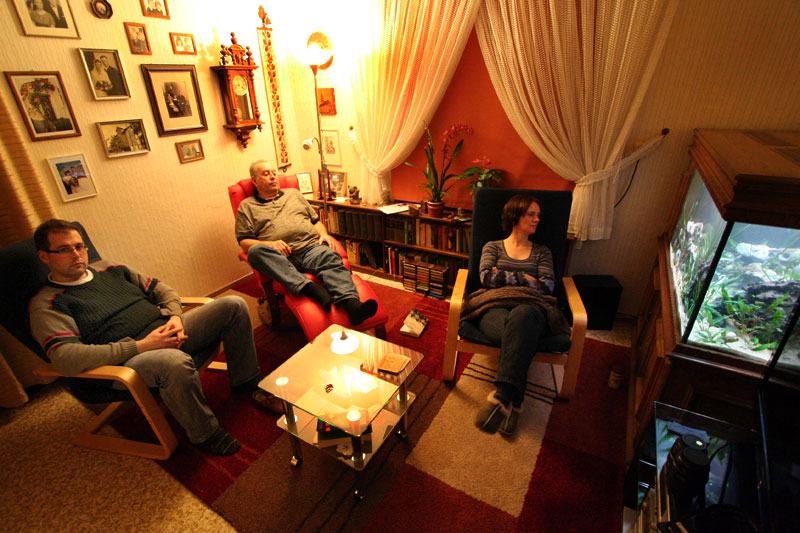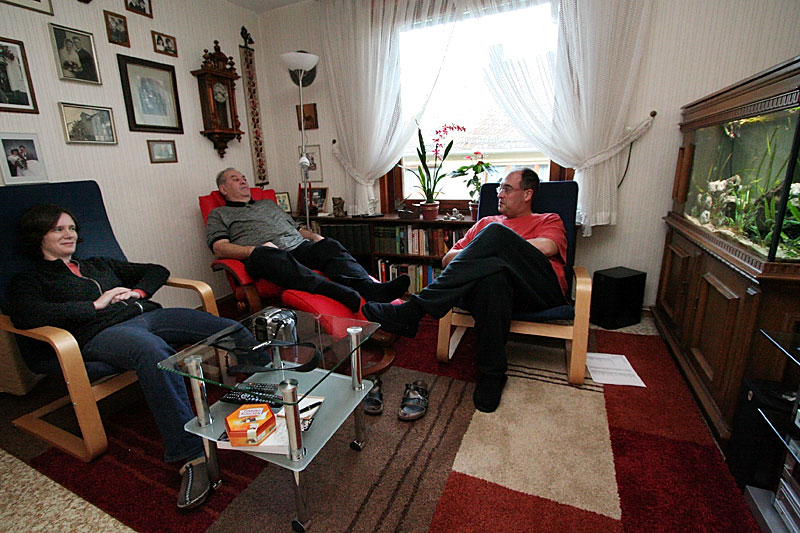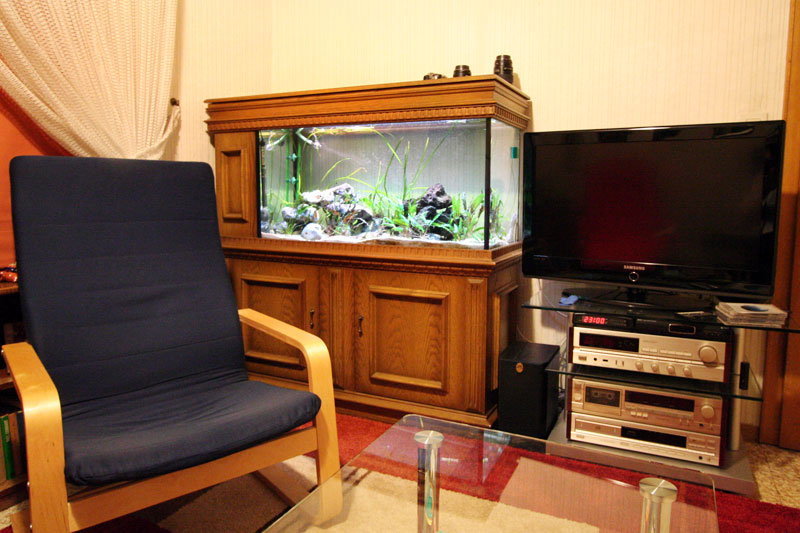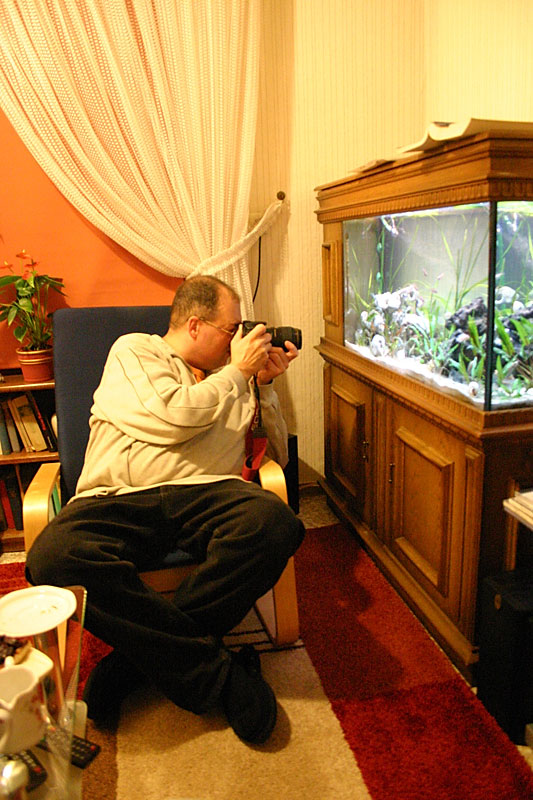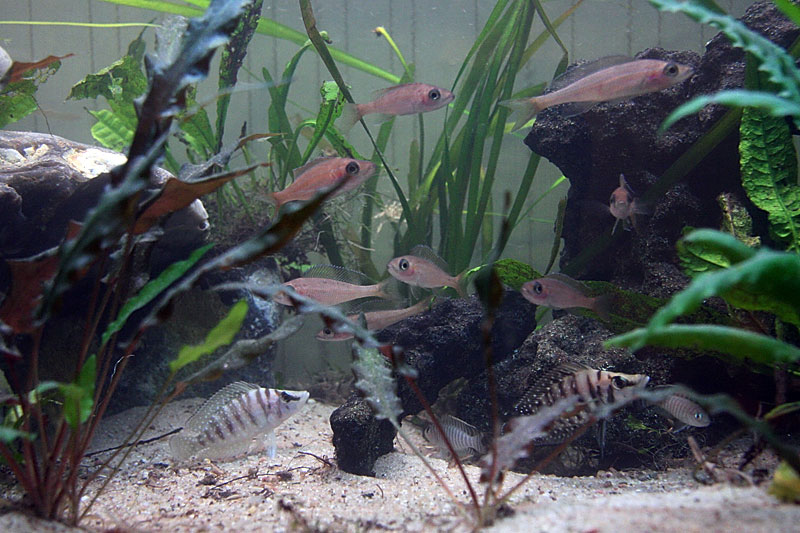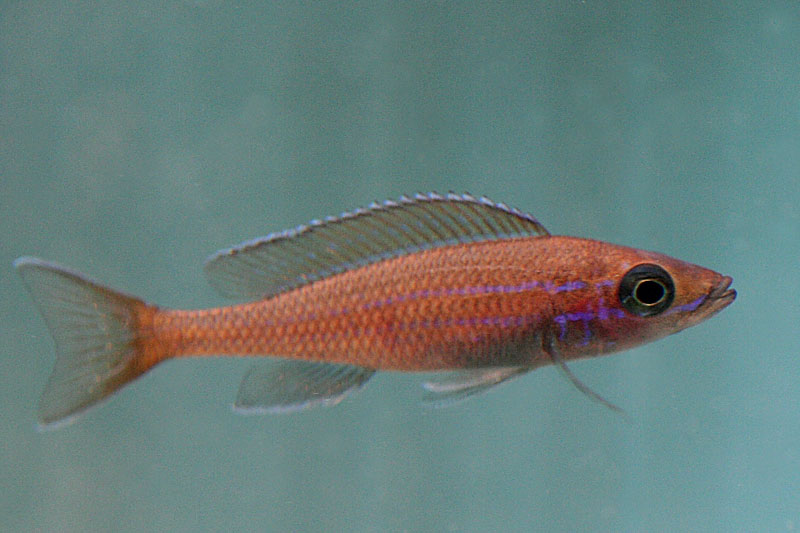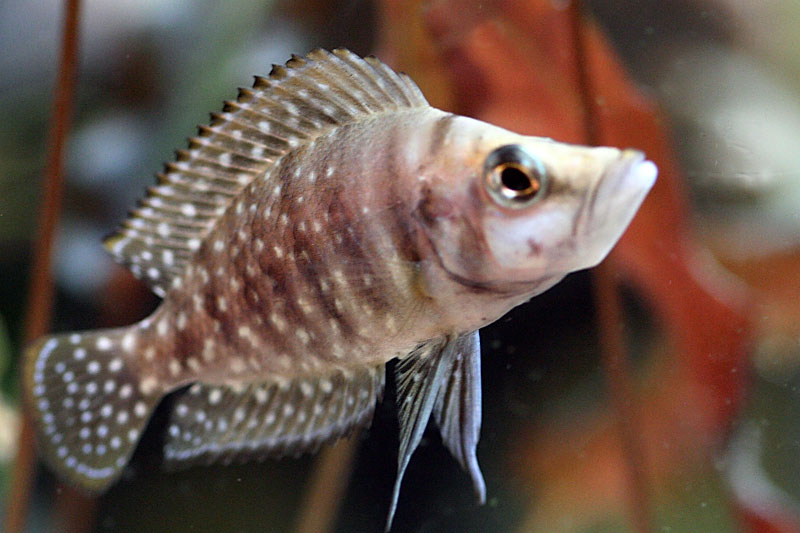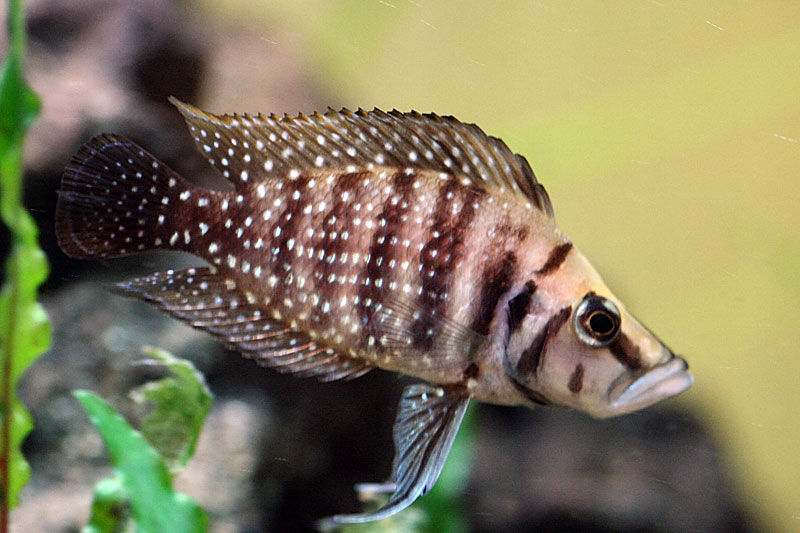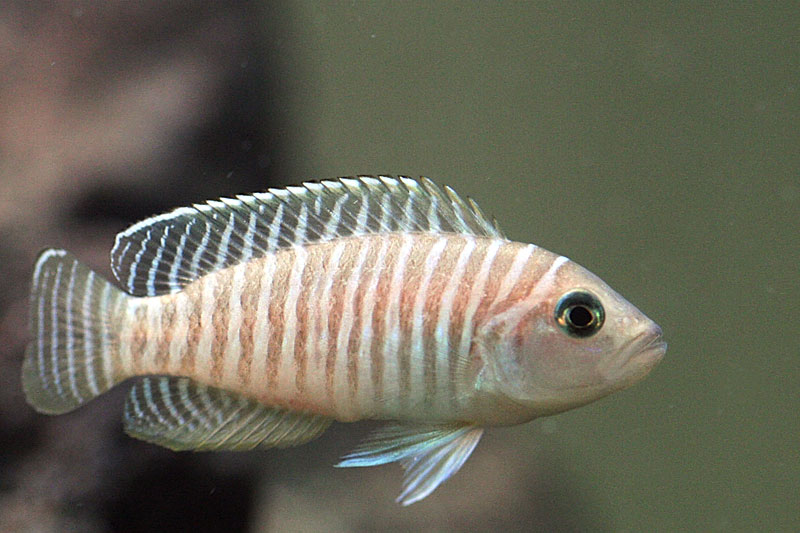Getting Hooked
How I got into the Aquaristic Hobby
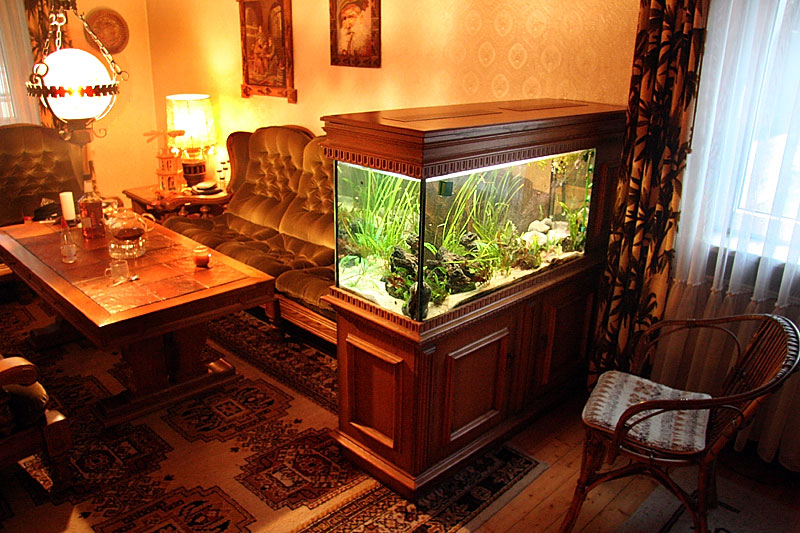 My first tank - a beautiful 200 liter tank set up as room divider in my parents' living room complete with oak cabinet and hood to match the furniture.
I have had fish tanks as long as I can think back. Well, it depends what you consider to be a 'tank'. Initially they were jars, bottles, whatever I could lay my hands on, and they contained water snails, insect larvae, gammarus, algae, and similar aquatic treasures. My first real tank I got in 1977, and I was 10 at the time. My Dad liked to do things properly - his words. If you listened to my mom, he tended to overdo things. For example when we built a hutch for our chickens, the thing ended up being so well insulated that we had to cut a hole in the roof and put a make-shift chimney on there to allow for a little air circulation. The chicken house chimney, which was made from the finest stainless steel, didn't worry my Mom so much,
My first tank - a beautiful 200 liter tank set up as room divider in my parents' living room complete with oak cabinet and hood to match the furniture.
I have had fish tanks as long as I can think back. Well, it depends what you consider to be a 'tank'. Initially they were jars, bottles, whatever I could lay my hands on, and they contained water snails, insect larvae, gammarus, algae, and similar aquatic treasures. My first real tank I got in 1977, and I was 10 at the time. My Dad liked to do things properly - his words. If you listened to my mom, he tended to overdo things. For example when we built a hutch for our chickens, the thing ended up being so well insulated that we had to cut a hole in the roof and put a make-shift chimney on there to allow for a little air circulation. The chicken house chimney, which was made from the finest stainless steel, didn't worry my Mom so much,  but she always said that other people could built a house for what my Dad spend on the chicken hutch. And so it went with my first fish tank. Instead of the usual little 40 liter setup kids might have got, my Dad went out and bought a whopping 200 liter tank that was set up as room divider in the midst of the living room. To match the furniture, it came complete with an elaborately carved antique oak cabinet and hood. Filtration was provided by an Eheim 2213 canister filter - yes that's right, the essentially same filter that is still available today in Eheim's classic series. The tank even had fluorescent lighting controlled by a timer - the latter a bit of a rarity in the pre-computer age.
In 1977 my family had a holiday at the Baltic Sea (Insel Fehmarn), and my parents encouraged us kids to collect rocks with holes in them, that looked very similar to the holey rock, which is so popular for aquarium decorations in the US today. These rocks we used as tank decorations, as well as some local rocks and of course plenty of life plants - I have yet to see a tank with plastic plants in Germany! The first fish going into that tank were 10 Neon Tetras (Paracheirodon innesi), and over the years it has housed most of the typical community tank fish, such as the standard lifebearers, tetras, loaches, catfish, and dwarf cichlids. I've never been partial to barbs and gouramis, and believe we always steered clear of those. Clown loaches (Chromobotia macracanthus) and a red-tailed shark (Epalzeorhynchus bicolor) were family favorites for many years. As a 10 year old I needed some help with taking care of that tank. For example the oak canopy needed to be lifted off completely before you could reach with your hands into the water (feeding is done through a little hole), but the canopy weighs a ton, and only a good sized adult can take it off without help. This, by the way, is the main problem my Dad, who is approaching 70 now, has in maintaining this tank, which is still set up in his living room in Germany. Even as a 10 year old, it was largely my responsibility to make sure that the tank was clean, looked ok, and its inhabitants were well taken care of. Maybe everything looks better in hindsight, but I believe I always enjoyed that responsibility.
As mentioned earlier, occasionally we housed cichlids in this community tank with varying success, but they were always my favorites. Like most other beginning fish keepers, of course I tried my hand at angelfish (Pterophyllum scalare), and occasionally even got them to spawn. But being confined to this single tank with the possible addition of a spawning box (that could not be accessed without removing the heavy canopy), I never managed to raise any fry, and the angelfish had an annoying tendency to harass each other until only the strongest one survived. We also tried kribs (Pelvicachromis pulcher), which I don't believe ever spawned, and German Blue Rams (Microgeophagus ramirezi), which spawned but always ate their eggs. The first real spawning success we had was when my brother, who otherwise rarely took an interest in the tank, got a pair of convicts (Archocentrus nigrofasciatus). Within no time the tank was populated by hundreds of fry, and my Mom was so smitten by the little fish that she went out and bought a 60 liter tank to be set up in my brother's room as a species tank for the convicts. Of course before long, owners of local fish stores in our area knew to hide behind their counters when they saw us approach the store - my brother with a bag of convict fry in hand. For a long time the only tank mates of the convicts were a pair on Bristle Nose Plecos (Anchistrus sp.), which seemed to spend most of their life hiding behind a piece of slate. At one time a pleco was chased by the convict male until it jumped right out of the tank and onto the carpet. This was too much for my brother, and he returned the convict to one of the store keepers, who probably took them just to make sure my brother wouldn't turn up at his store again with another bag of fry. As soon as the plecos were left to themselves they proceeded to populate that tank with their offspring as least as vigorously as the convicts had done before, only that the shopkeepers were more than happy to take the pleco fry off my brother's hands, and even gave store credit in return.
OK, so far about the plecos, but I guess part of what me got hooked on cichlids were those convicts. The other part was a fantastic store about 15 miles from my parents place. This was Aquaristik Fernholz, which only stopped operating around 2007 as a fish store, but is still active as a tank manufacturer under a new name of Fernium. In the late 1970s the store was small and situated in the basement of it's owner's home, but it already offered a mind boggling variety of fish that were unlike the community type fish commonly found in pet stores. The owners specialized in cichlids, and especially African rift lake cichlids, which at the time were brand spanking new for most people in the hobby. I vividly remember seeing huge specimen of frontosa, altolamprologus, and tropheus, as well as countless mbuna, haps, and peacocks. In fact, I am pretty sure the owner's frontosa were the ones who took care of most of my brother's convict fry! I frequented this store for many years, and my first visit was always to the rows of tanks with African cichlids in the back - before I had to return to the front of the store to choose some community fish for my own tank. I also read many books - all in German - including many of the classics by Hans J. Mayland. The little paperbacks in the "Lehrmeister Bücherei" series were especially affordable for a schoolboy like myself. Among numerous others, I still own the volumes on "Die Buntbarsche des Tanganjika Sees", "Die Buntbarsche des Malawisees" and "Die Buntbarsche Amerikas". The few books that one could lay one's hands on where all one had to go by at the time. I still marvel at the free flow of information that takes place nowadays between hobbyists using the Internet on sites like Cichlid-Forum, Cichlid Room Companion, and Malawipoint (the latter is in German).
but she always said that other people could built a house for what my Dad spend on the chicken hutch. And so it went with my first fish tank. Instead of the usual little 40 liter setup kids might have got, my Dad went out and bought a whopping 200 liter tank that was set up as room divider in the midst of the living room. To match the furniture, it came complete with an elaborately carved antique oak cabinet and hood. Filtration was provided by an Eheim 2213 canister filter - yes that's right, the essentially same filter that is still available today in Eheim's classic series. The tank even had fluorescent lighting controlled by a timer - the latter a bit of a rarity in the pre-computer age.
In 1977 my family had a holiday at the Baltic Sea (Insel Fehmarn), and my parents encouraged us kids to collect rocks with holes in them, that looked very similar to the holey rock, which is so popular for aquarium decorations in the US today. These rocks we used as tank decorations, as well as some local rocks and of course plenty of life plants - I have yet to see a tank with plastic plants in Germany! The first fish going into that tank were 10 Neon Tetras (Paracheirodon innesi), and over the years it has housed most of the typical community tank fish, such as the standard lifebearers, tetras, loaches, catfish, and dwarf cichlids. I've never been partial to barbs and gouramis, and believe we always steered clear of those. Clown loaches (Chromobotia macracanthus) and a red-tailed shark (Epalzeorhynchus bicolor) were family favorites for many years. As a 10 year old I needed some help with taking care of that tank. For example the oak canopy needed to be lifted off completely before you could reach with your hands into the water (feeding is done through a little hole), but the canopy weighs a ton, and only a good sized adult can take it off without help. This, by the way, is the main problem my Dad, who is approaching 70 now, has in maintaining this tank, which is still set up in his living room in Germany. Even as a 10 year old, it was largely my responsibility to make sure that the tank was clean, looked ok, and its inhabitants were well taken care of. Maybe everything looks better in hindsight, but I believe I always enjoyed that responsibility.
As mentioned earlier, occasionally we housed cichlids in this community tank with varying success, but they were always my favorites. Like most other beginning fish keepers, of course I tried my hand at angelfish (Pterophyllum scalare), and occasionally even got them to spawn. But being confined to this single tank with the possible addition of a spawning box (that could not be accessed without removing the heavy canopy), I never managed to raise any fry, and the angelfish had an annoying tendency to harass each other until only the strongest one survived. We also tried kribs (Pelvicachromis pulcher), which I don't believe ever spawned, and German Blue Rams (Microgeophagus ramirezi), which spawned but always ate their eggs. The first real spawning success we had was when my brother, who otherwise rarely took an interest in the tank, got a pair of convicts (Archocentrus nigrofasciatus). Within no time the tank was populated by hundreds of fry, and my Mom was so smitten by the little fish that she went out and bought a 60 liter tank to be set up in my brother's room as a species tank for the convicts. Of course before long, owners of local fish stores in our area knew to hide behind their counters when they saw us approach the store - my brother with a bag of convict fry in hand. For a long time the only tank mates of the convicts were a pair on Bristle Nose Plecos (Anchistrus sp.), which seemed to spend most of their life hiding behind a piece of slate. At one time a pleco was chased by the convict male until it jumped right out of the tank and onto the carpet. This was too much for my brother, and he returned the convict to one of the store keepers, who probably took them just to make sure my brother wouldn't turn up at his store again with another bag of fry. As soon as the plecos were left to themselves they proceeded to populate that tank with their offspring as least as vigorously as the convicts had done before, only that the shopkeepers were more than happy to take the pleco fry off my brother's hands, and even gave store credit in return.
OK, so far about the plecos, but I guess part of what me got hooked on cichlids were those convicts. The other part was a fantastic store about 15 miles from my parents place. This was Aquaristik Fernholz, which only stopped operating around 2007 as a fish store, but is still active as a tank manufacturer under a new name of Fernium. In the late 1970s the store was small and situated in the basement of it's owner's home, but it already offered a mind boggling variety of fish that were unlike the community type fish commonly found in pet stores. The owners specialized in cichlids, and especially African rift lake cichlids, which at the time were brand spanking new for most people in the hobby. I vividly remember seeing huge specimen of frontosa, altolamprologus, and tropheus, as well as countless mbuna, haps, and peacocks. In fact, I am pretty sure the owner's frontosa were the ones who took care of most of my brother's convict fry! I frequented this store for many years, and my first visit was always to the rows of tanks with African cichlids in the back - before I had to return to the front of the store to choose some community fish for my own tank. I also read many books - all in German - including many of the classics by Hans J. Mayland. The little paperbacks in the "Lehrmeister Bücherei" series were especially affordable for a schoolboy like myself. Among numerous others, I still own the volumes on "Die Buntbarsche des Tanganjika Sees", "Die Buntbarsche des Malawisees" and "Die Buntbarsche Amerikas". The few books that one could lay one's hands on where all one had to go by at the time. I still marvel at the free flow of information that takes place nowadays between hobbyists using the Internet on sites like Cichlid-Forum, Cichlid Room Companion, and Malawipoint (the latter is in German).
 My collection of little softcover books about aquaristic from the Lehrmeister Bücherei.
I never managed to convince my parents to convert the 200 liter tank in the living room into a cichlid empire - the little tetras where too much loved. For a long time I had neither the money nor the space to put a tank necessary to keep the cichlids I desired in my little room. However, in 1991 my grandparents, who had lived downstairs from us, had passed away and I moved into some of their rooms. I immediately went ahead and bought another 200 liter tank. This time it was a Fernholz tank with plastic canopy. This tank was stocked with four (1 male, 3 female) Pseudotropheussp. 'Zebra Rot' - Red Zebras or Maylandia estherae, as they are called today. It was the variety with the blue males and orange colored females. I enjoyed them for many years, and they produced numerous fry for me, although few managed to grow up in the tank. It seems strange to me now that I didn't go with a pure cichlid setup, but initially I actually had a range of catfish and loaches in that tank as well, some of which I believe to have been Microglanis ihering, Dysichthys coracoideus, and Botia morleti. In addition I did something else which I eschew today, and that is creating a mixed lake setup by adding a trio of Neolamprologus pulcher 'daffodil' to the tank. The mbuna and lamps actually got along pretty well, with the mbuna staying on the left-hand side of the tank, where I had built a huge slate labyrinth, while the lamps restrained themselves to the right-hand side, where there was a smaller slate cave and some driftwood. The substrate spawning lamps seemed to enjoy the far greater breeding success than the mouth breeding mbunas, that is their numbers grew steadily until there were about 40 in the tank, while the number of mbunas grew only by 2 or 3. I attribute this to the fact that the lamps form a huge colony in which older siblings help the parents to defend younger fry against any intruder, while the mbuna fight each for themselves, and the parents and older siblings will readily devour the younger fry if they can get hold of them. The Brichardi were my first Lake Tanganyika cichlids, and while I have sometimes regretted the mixed lake setup, I have never regretted keeping the Brichardi with their fascinating breeding behavior. Ever since this time I have been meaning to keep another colony of lamps of the Brichardi family, and while so far this hasn't eventuated, it’s still on my to-do list.
After about a year with this setup I decided to correct my stocking 'mistakes' and create a Lake Malawi Setup focusing on mbuna. The catfish and loaches all went into my old community setup in the living room, and I took the whole colony of daffodils to Aquaristik Fernholz, where I got a store credit of DM2 per fish. For this money, I bought four Melanochromis auratus (1 male, 3 female) and four plecos (Peckoltia sp., possibly vermiculata), which were nice, because they stayed even smaller than bristle nose plecos (Ancistrus sp.), but unfortunately they never bred for me. The mbuna females in this setup where constantly holding, but fry rarely managed to grow up. As the fish matured, they started to put strain on the water quality, and I decided to upgrade the filtration from an Eheim 2213 to an Eheim 2215 to lessen the workload somewhat. More importantly though, aggression became a real issue, and after two years I had enough of mbuna beating each other up, sold the whole bunch, and replaced them with a mix of haps and peacocks (sold to me at the time as Haplochromis sp. 'Gelbe Kaiser' and Aulonocara sp. 'Blue Orchid), as well as four Labidochromis caeruleus. This setup was a lot more peaceful, and I was very happy with it. Unfortunately little more than a year after this last change, I had to give up fish keeping for a while, because I had finished my PhD and left my parents' place to take up a postdoctoral position in Amsterdam. I had also recently met my future wife, a New Zealander, and I knew that I might not return to Germany to live there. Indeed, after a year in Amsterdam we went together to Fort Collins, CO for a year, and then lived for about four years in Canberra, Australia. All of these places were only temporary residences for me, although we contemplated staying in Australia for a while. I hated the experience of having to give up my tanks in Germany, and I did not want to repeat this, which is why I never took up fish keeping during those years. Only after we had settled down in Ohio and bought a house, I returned to the hobby, and this time I did not want to be as restricted in my stocking choices as I had been with the 200 liter tank in Germany.
My collection of little softcover books about aquaristic from the Lehrmeister Bücherei.
I never managed to convince my parents to convert the 200 liter tank in the living room into a cichlid empire - the little tetras where too much loved. For a long time I had neither the money nor the space to put a tank necessary to keep the cichlids I desired in my little room. However, in 1991 my grandparents, who had lived downstairs from us, had passed away and I moved into some of their rooms. I immediately went ahead and bought another 200 liter tank. This time it was a Fernholz tank with plastic canopy. This tank was stocked with four (1 male, 3 female) Pseudotropheussp. 'Zebra Rot' - Red Zebras or Maylandia estherae, as they are called today. It was the variety with the blue males and orange colored females. I enjoyed them for many years, and they produced numerous fry for me, although few managed to grow up in the tank. It seems strange to me now that I didn't go with a pure cichlid setup, but initially I actually had a range of catfish and loaches in that tank as well, some of which I believe to have been Microglanis ihering, Dysichthys coracoideus, and Botia morleti. In addition I did something else which I eschew today, and that is creating a mixed lake setup by adding a trio of Neolamprologus pulcher 'daffodil' to the tank. The mbuna and lamps actually got along pretty well, with the mbuna staying on the left-hand side of the tank, where I had built a huge slate labyrinth, while the lamps restrained themselves to the right-hand side, where there was a smaller slate cave and some driftwood. The substrate spawning lamps seemed to enjoy the far greater breeding success than the mouth breeding mbunas, that is their numbers grew steadily until there were about 40 in the tank, while the number of mbunas grew only by 2 or 3. I attribute this to the fact that the lamps form a huge colony in which older siblings help the parents to defend younger fry against any intruder, while the mbuna fight each for themselves, and the parents and older siblings will readily devour the younger fry if they can get hold of them. The Brichardi were my first Lake Tanganyika cichlids, and while I have sometimes regretted the mixed lake setup, I have never regretted keeping the Brichardi with their fascinating breeding behavior. Ever since this time I have been meaning to keep another colony of lamps of the Brichardi family, and while so far this hasn't eventuated, it’s still on my to-do list.
After about a year with this setup I decided to correct my stocking 'mistakes' and create a Lake Malawi Setup focusing on mbuna. The catfish and loaches all went into my old community setup in the living room, and I took the whole colony of daffodils to Aquaristik Fernholz, where I got a store credit of DM2 per fish. For this money, I bought four Melanochromis auratus (1 male, 3 female) and four plecos (Peckoltia sp., possibly vermiculata), which were nice, because they stayed even smaller than bristle nose plecos (Ancistrus sp.), but unfortunately they never bred for me. The mbuna females in this setup where constantly holding, but fry rarely managed to grow up. As the fish matured, they started to put strain on the water quality, and I decided to upgrade the filtration from an Eheim 2213 to an Eheim 2215 to lessen the workload somewhat. More importantly though, aggression became a real issue, and after two years I had enough of mbuna beating each other up, sold the whole bunch, and replaced them with a mix of haps and peacocks (sold to me at the time as Haplochromis sp. 'Gelbe Kaiser' and Aulonocara sp. 'Blue Orchid), as well as four Labidochromis caeruleus. This setup was a lot more peaceful, and I was very happy with it. Unfortunately little more than a year after this last change, I had to give up fish keeping for a while, because I had finished my PhD and left my parents' place to take up a postdoctoral position in Amsterdam. I had also recently met my future wife, a New Zealander, and I knew that I might not return to Germany to live there. Indeed, after a year in Amsterdam we went together to Fort Collins, CO for a year, and then lived for about four years in Canberra, Australia. All of these places were only temporary residences for me, although we contemplated staying in Australia for a while. I hated the experience of having to give up my tanks in Germany, and I did not want to repeat this, which is why I never took up fish keeping during those years. Only after we had settled down in Ohio and bought a house, I returned to the hobby, and this time I did not want to be as restricted in my stocking choices as I had been with the 200 liter tank in Germany.
December 2008
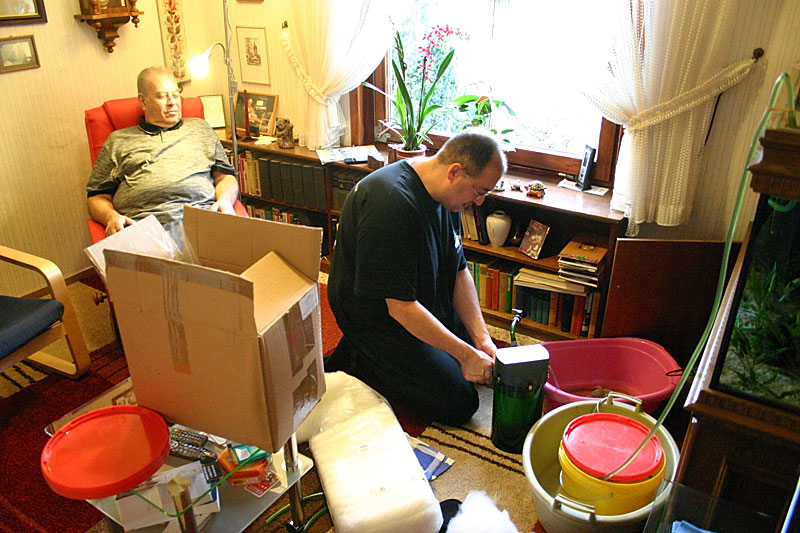 Setting up the tank in a new location - but still with a trusty Eheim 2215 full of filter floss!
After not having visited Germany for five years, in 2008 my wife and I decided to spend X-mas at my dad's place. He had just turned 70 in November, and we were in need of a largish present, so my wife, my brother and I decided to make this a room remodeling. Since my mom had passed away in 1996, my dad was reluctant to use our old, large living room, and the dining room didn't see much use as well. So we decided to turn the dining room into a nice sitting room for my dad. The main items we purchased were a comfortable chair, a nice rug, and a flat screen TV.
Most importantly for the purposes of this page, we moved the old aquarium from the living room into this new room. In the process, I managed to modify the hood, so that only the lighting a glass tops have to be removed to access the tank, not the entire hood. This should make maintenance a lot easier for my dad. If you know my preference from my other tanks shown on this site, you might have guessed that I remodeled the tank as a Tanganyika community setup - finally the tank turned into a cichlid empire after all! Since my old favorite store Fernholz Aquaristic was no longer selling fish, I had the hardest time of locating suitable Tanganyikan cichlids, and in the end I decided to do what I have recommended to countless people on Cichlid-forum - check with your local club! As a member of the DCG (German Cichlid Society), I asked in their internet forum, and found out that a notable importer and breeder of rift lake cichlids, Mal-Ta-Vi, was located about half an hours drive from my parents place ever since the 1980s - I fact that had been completely unknown to me! I immediately made contact, and was stunned by the beautiful selection of rift lake cichlids Mal-Ta-Vi had to offer - even more so when I learned of their bargain (whole-sale) prices! Unfortunately in the excitement of discovering that store I forgot to take my camera when I went - a mistake I am planning to rectify during my next visit to Germany, currently planned for August 2009. Enough of the talking, below are some photos of my first fish tank and it's new location as it looks in 2009; that is 30 years after I first got it.
The stoking list is:
8x Paracyprichromis nigripinnis 'Blue Neon'
Setting up the tank in a new location - but still with a trusty Eheim 2215 full of filter floss!
After not having visited Germany for five years, in 2008 my wife and I decided to spend X-mas at my dad's place. He had just turned 70 in November, and we were in need of a largish present, so my wife, my brother and I decided to make this a room remodeling. Since my mom had passed away in 1996, my dad was reluctant to use our old, large living room, and the dining room didn't see much use as well. So we decided to turn the dining room into a nice sitting room for my dad. The main items we purchased were a comfortable chair, a nice rug, and a flat screen TV.
Most importantly for the purposes of this page, we moved the old aquarium from the living room into this new room. In the process, I managed to modify the hood, so that only the lighting a glass tops have to be removed to access the tank, not the entire hood. This should make maintenance a lot easier for my dad. If you know my preference from my other tanks shown on this site, you might have guessed that I remodeled the tank as a Tanganyika community setup - finally the tank turned into a cichlid empire after all! Since my old favorite store Fernholz Aquaristic was no longer selling fish, I had the hardest time of locating suitable Tanganyikan cichlids, and in the end I decided to do what I have recommended to countless people on Cichlid-forum - check with your local club! As a member of the DCG (German Cichlid Society), I asked in their internet forum, and found out that a notable importer and breeder of rift lake cichlids, Mal-Ta-Vi, was located about half an hours drive from my parents place ever since the 1980s - I fact that had been completely unknown to me! I immediately made contact, and was stunned by the beautiful selection of rift lake cichlids Mal-Ta-Vi had to offer - even more so when I learned of their bargain (whole-sale) prices! Unfortunately in the excitement of discovering that store I forgot to take my camera when I went - a mistake I am planning to rectify during my next visit to Germany, currently planned for August 2009. Enough of the talking, below are some photos of my first fish tank and it's new location as it looks in 2009; that is 30 years after I first got it.
The stoking list is:
8x Paracyprichromis nigripinnis 'Blue Neon'3x Altolamprologus calvus 'Black'
6x Neolamprologus similis
Leave a Reply
You must be logged in to post a comment.

